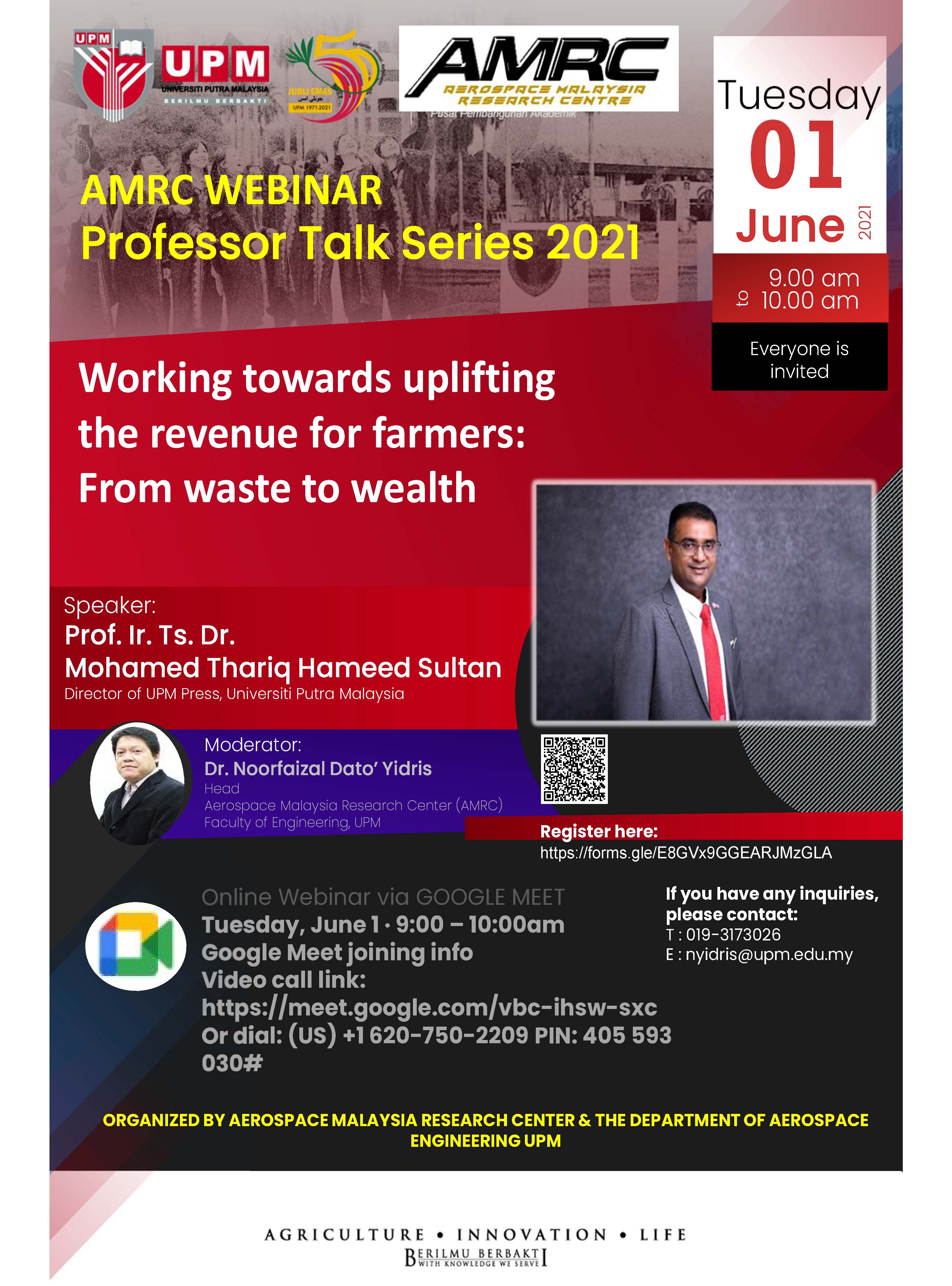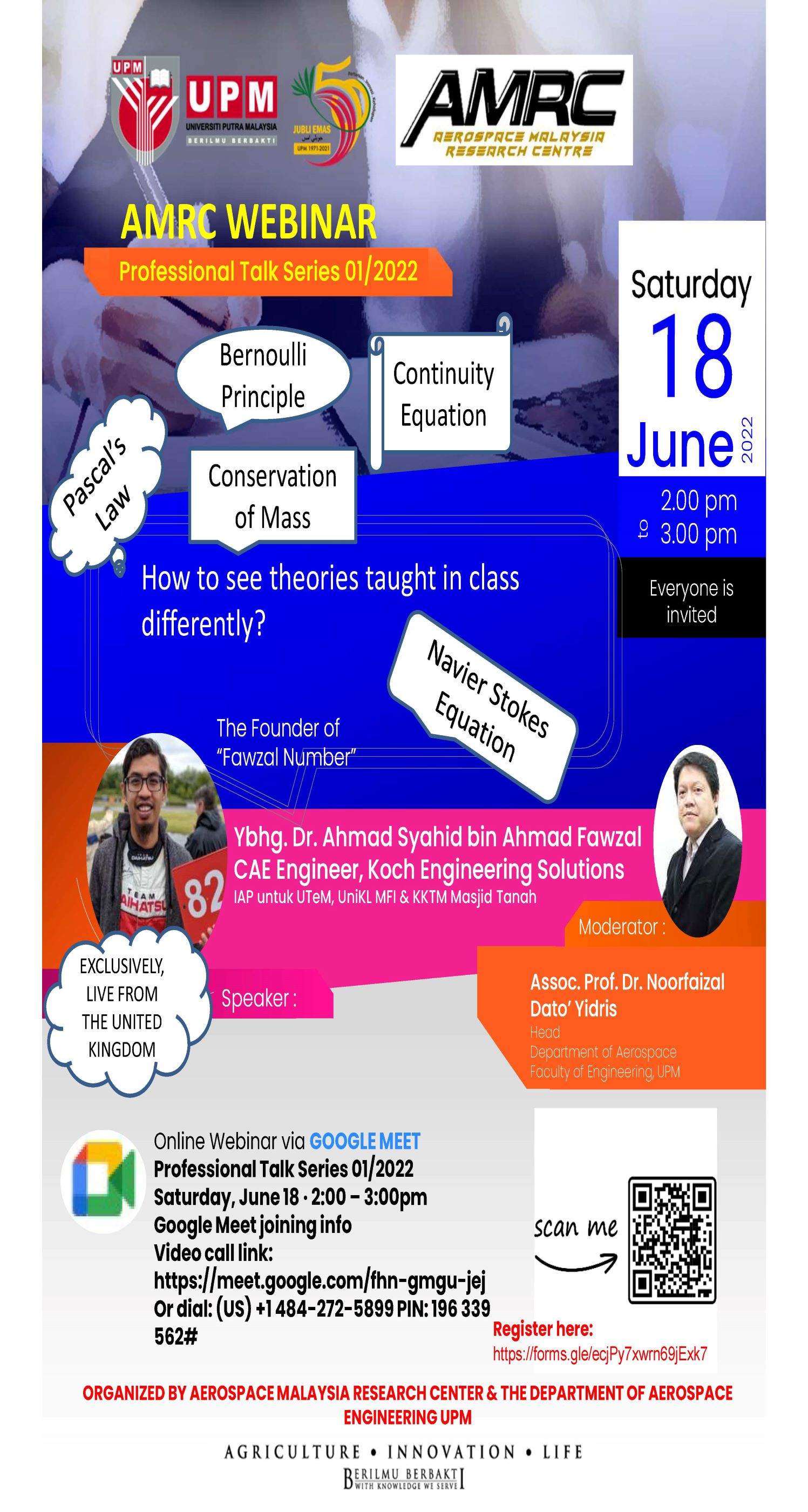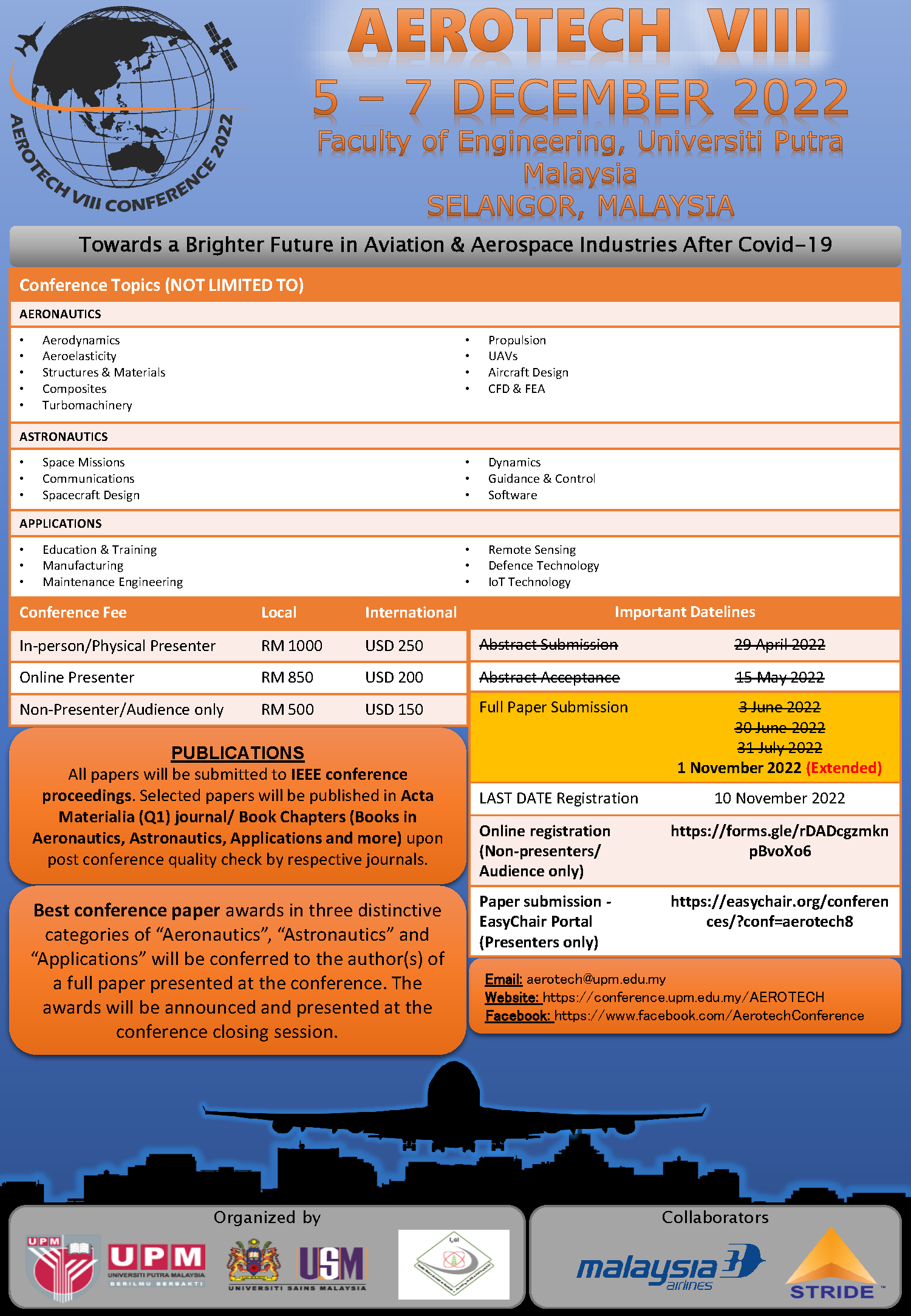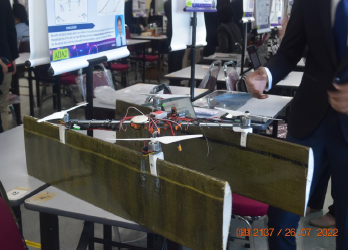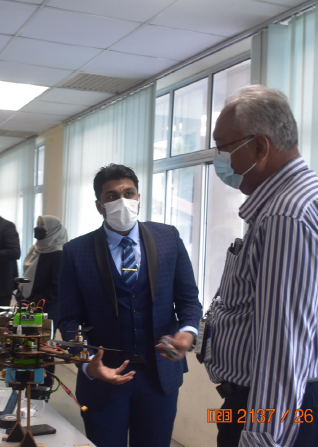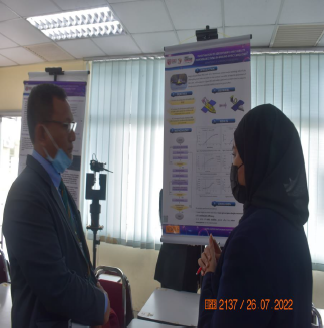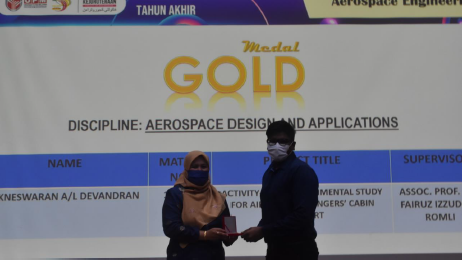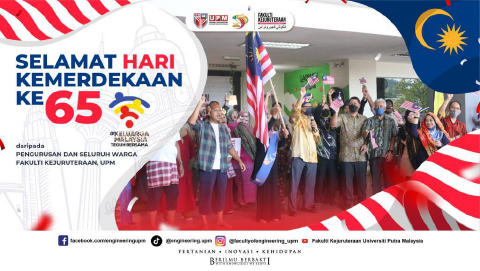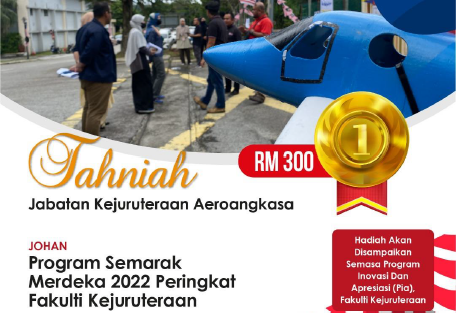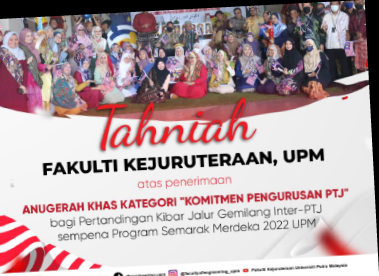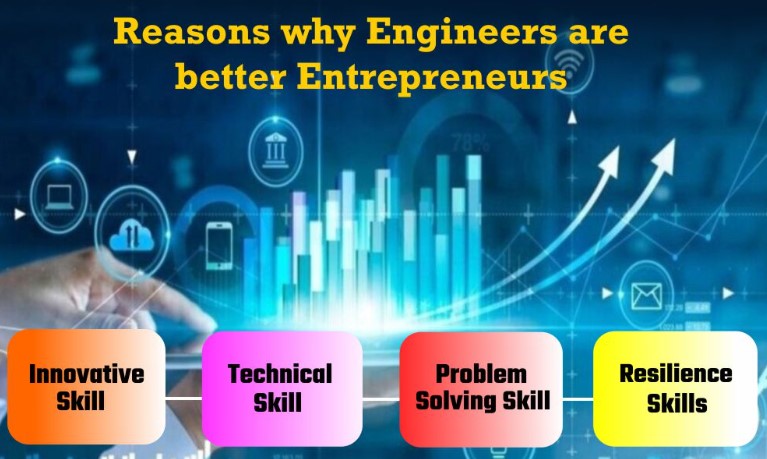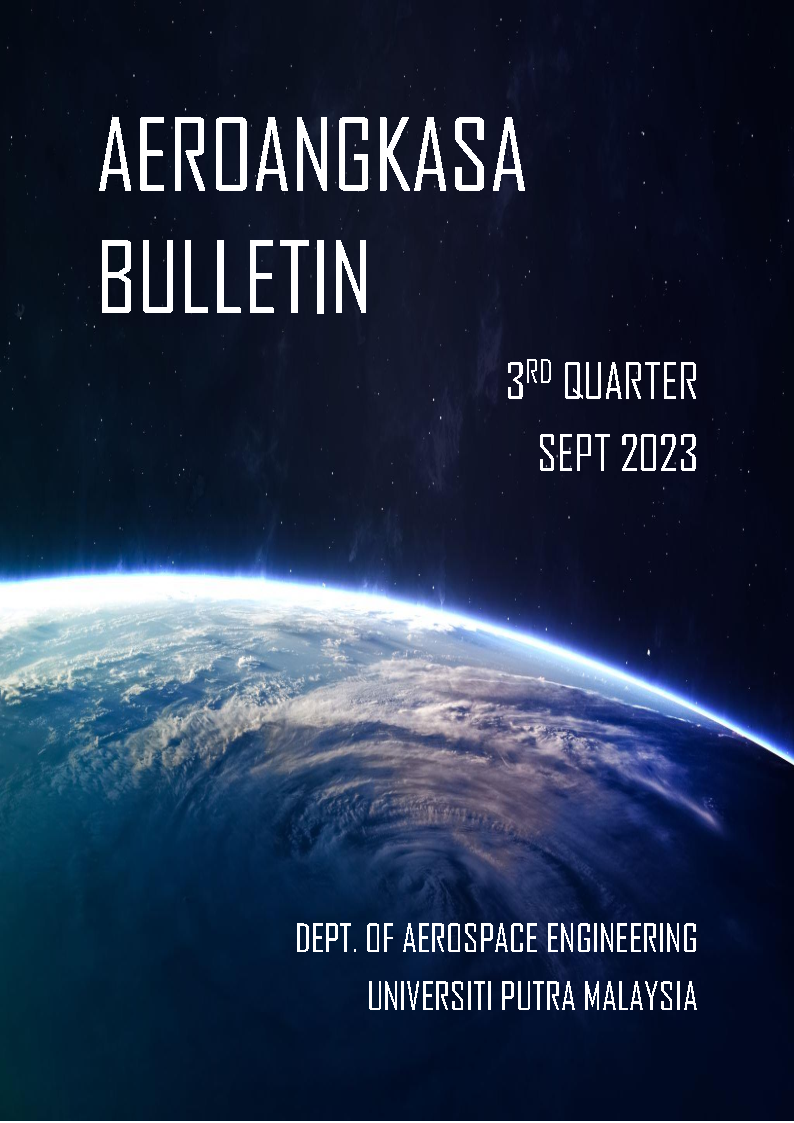AEROSPACE Newsletter
This bulletin is a media reporting on articles and activities carried out by the Department of Aerospace Engineering, Faculty of Engineering, Universiti Putra Malaysia
Editorial Board
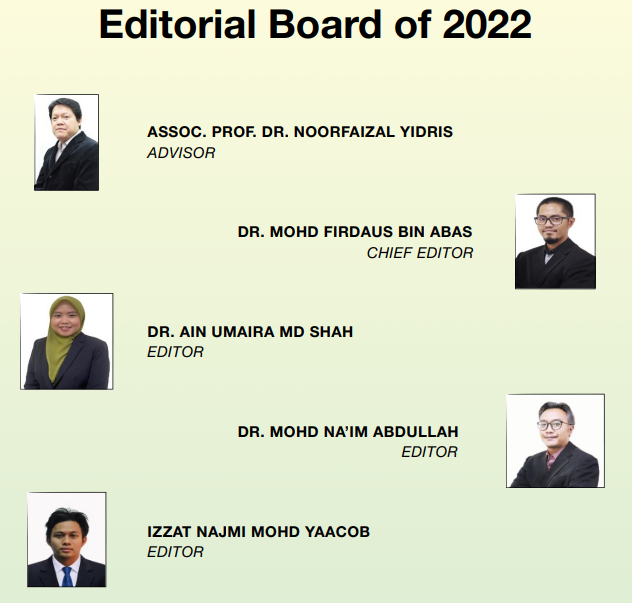
___________________________________________________________________________________________________________________________________________________________________
Published: August 22, 2022 9:30 am Updated: August 22, 2022 11:30 am
AMRC Webinar Profesional Talk Series held starting 2021 online, is a medium for the department to share knowledge. The AMRC Talk Objective is to provide a platform for academics,experts and industry players to share their thoughts, expertise, knowledge and experiences with the community and students.This activity is organised by Aerospace Malaysia Research Centre (AMRC) whose members consist of academic officers in the department.
Master in Aerospace System Design Engineering
The Master of Aerospace System Design Engineering (MASDE) programme is specifically designed to prepare you for a professional future leading large, complex projects in aerospace engineering. Through extensive courses and research projects, you will master cutting-edge aerospace engineering methodologies and apply them to real-world issues. Furthermore, earning the necessary skills to bring your ideas to reality. UPM, ranked in the QS top 200 universities, offers a one-of-a-kind coursework Master programme in Malaysia, encompassing both aeronautics and astronautics. In addition, through collaborations with Malaysia Airline Berhad, you will have the opportunity to be on-site for observing and capturing Engineering data for research purposes and aid further development.
Programme Coordinator
Dr. Syamimi Saadon
Tel: 603-9769 4390
Email: mimisaadon@upm.edu.my
http://www.eng.upm.edu.my
Click here for details. How to apply.
AEROTECH VIII Conference 2022
"Towards a Brighter Future in Aviation & Aerospace Industries After Covid-19"
Call for Papers
8th AEROTECH Conference on Aeronautics, Astronautics, and Applications 2022
5-7 December 2022, Faculty of Engineering, University Putra Malaysia, Selangor, Malaysia
The scope of AEROTECH VIII Conference 2022 shall include but not be restricted to the topics given below:
| AERONAUTICS |
ASTRONAUTICS |
APPLICATIONS |
| Aerodynamics |
Space Missions |
Education & Training |
| Aeroelasticity |
Communications |
Manufacturing |
| Structures & Materials |
Spacecraft Design |
Maintenance Engineering |
| Composites |
Dynamics |
Remote Sensing |
| Turbomachinery |
Guidance & Control |
Defense Technology |
| Propulsion |
Software |
IoT Technology |
| UAVs |
|
|
| Aircraft Design |
|
|
| CFD & FEA |
|
|
Publication
All papers will be submitted to IEEE Conference Proceedings. Selected papers will be published in Acta Materialia (Q1) Journal / Book Chapters (Books in Aeronautics, Astronautics, Applications, and more) upon post-conference quality check by respective Journals.
Best Conference Paper awards in three distinctive categories of "Aeronautics", "Astronautics", and "Applications" will be conferred to the author(s) of a full paper presented at the conference. The awards will be announced and presented at the conference closing session.
Important Dates
Full Paper Submission: 1 November 2022 (EXTENDED)
LAST DATE for Registration: 10 November 2022
Registration and Submission
Conference Venue
AEROTECH VIII Conference 2022 will tentatively be held on UPM's Faculty of Engineering grounds.
Contact Us
For further details, kindly refer to the AEROTECH VIII Conference 2022 poster.
We welcome your participation and look forward to seeing you at UPM!!
__________________________________________________________________________________________________________________________________________________________________
Diterbitkan: November 7, 2022 5:30 petang Kemaskini: November 8, 2022 2:30 petang
Department Activities
1-BACHELOR DEGREE FINAL YEAR PROJECT EXHIBITION DAY
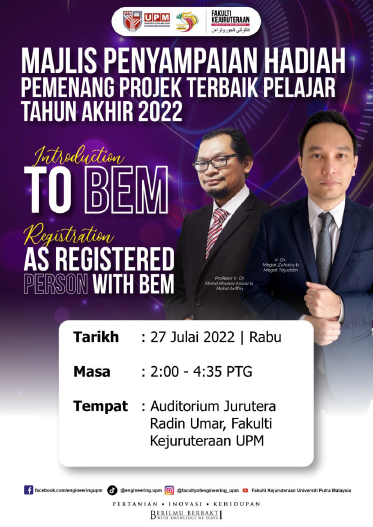

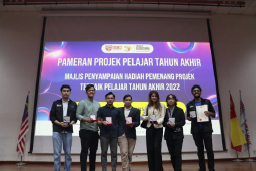
On 26 & 27 July 2022, Faculty of Engineering, University Putra Malaysia organized the Final Year Project Exhibition Day. It is an annual event for the undergraduate final year students. On this day, the final year students have to present their final year project and they will be evaluated by internal (UPM) and external (Industry) panelists.
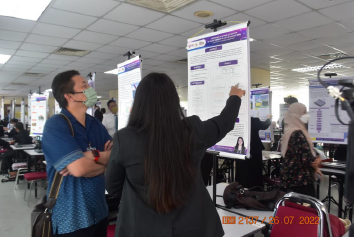
• The students also have to present their prototype, or research product based on their final year project.
• The external panelists are experienced individuals. They observe and assess projects that have possibilities to be implemented and can contribute to renown industrial partners.
• MAB, STRIDE, AMIC, and FAAS Engineering are among the invited Aerospace Companies assigned as panelists for the exhibition.
Dr. Umran from MAHB evaluating a project on biplane rotary UAV presented by Yavin, a student.
Mejar. Ir. Hj Abdul Kadir is also one of the external panelists
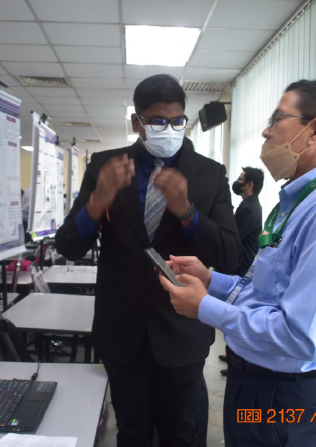
Mr. Ismail Sulaiman is very happy with the student presentations during the exhibition day
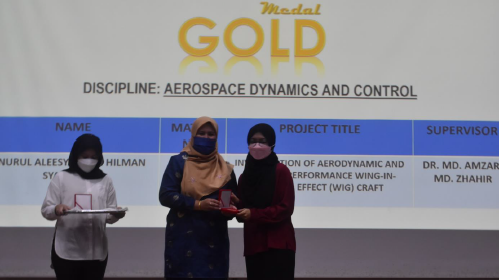
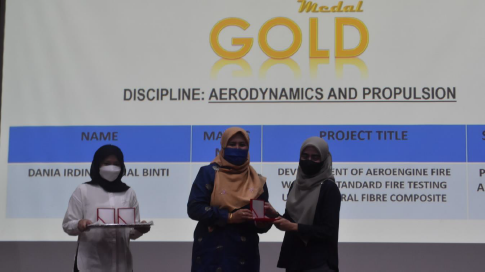
AMONG THE WINNERS OF FYP EXHIBITION DAY 2022
2-SEMARAK MERDEKA UPM
Pada 30 Ogos 2022, Fakulti Kejuruteraan Universiti Putra Malaysia telah mengadakan Pertandingan Kibar Jalur Gemilang bersempena Program Semarak Merdeka 2022 UPM. Pertandingan ini dilangsungkan di sekitar Fakulti Kejuruteraan dan setiap jabatan termasuk Jabatan Kejuruteraan Aeroangkasa mengambil bahagian dalam pertandingan ini.
Jabatan Aeroangkasa Dianugerahkan Pingat Emas Dalam Pertandingan Hiasan Bersempena Program Semarak Merdeka 2022 Peringkat Fakulti Kejuruteraan.
Tahniah Fakulti Kejuruteraan kerana telah dipilih sebagai pemenang dalam 10 terbaik dan mendapat Anugerah Perdana Jalur Gemilang Sempena Program Semarak Merdeka 2022. Fakulti Kejuruteraan juga mendapat anugerah khas kategori "Komitmen Pengurusan PTJ".

THE EDITOR
Izzat Najmi Bin Mohd Yaacob
Department of Aerospace Engineering Faculty of Engineering
University Putra Malaysia
_________________________________________________________________________________________________________________________________________________________________
Published: November 7, 2022 5:30 pm Updated: November 8, 2022 2:30 pm
Article of The Month
INSPIRED BY NATURE - BIOMIMETICS
Published: November 8, 2022 3:30 pm
Dr. Mohd Firdaus Bin Abas
firdaus.abas@upm.edu.my
 |
|
 |
Modern marvels. As human beings, we are blessed by Allah with the ability to understand, apply, and reinvent technical ingenuity into gigantic proportions with the advancement in current technology. But don’t be confused, modern marvels don’t always come in the form of enormous infrastructures. They also come in small sizes as well and sometimes, smaller than you think!
No scientific terms or technology for that matter, explains “Inspired By Nature” better than Biomimetics. And nothing speaks out “minute” louder than Micro-Aerial-Vehicles (MAV). Though a smaller aerial vehicle termed Nano-Aerial-Vehicle (NAV) already exists, let’s save the discussion on NAV for later issues and build our fundamental knowledge around MAVs.
As much as we would like to take all the credits. nature has been our most prominent source of reference and ever so often, she gave us hints on how to build effective and efficient man-made technologies if we ever seek for it.
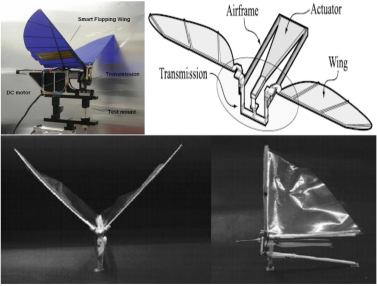
Fig. 1 Various Types of Bio-Mimicry; Generic Bird (Top-Left)[1], Fruit Fly (Top-Right)[2], and Butterfly (Bottom)[3]
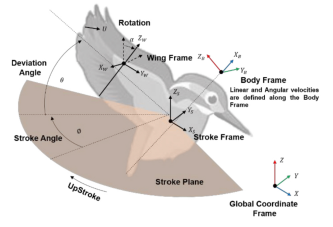
Fig. 2 Fyling Sequence of A Dwarf Kingfisher
By DARPA’s definition, a MAV should have a size limitation of 15 cm or less for its tip-to-tip span wise length and resides under the 15,000 Reynolds Number benchmark. To keep afloat during flight, a MAV, aligned with its bio-mimicry reference, needs to produce sufficient lift and thrust through unconventional, self-generated means, commonly known as wing flapping.
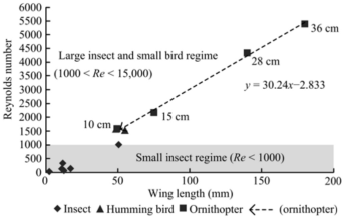
Fig. 3 Reynolds Number Versus Wing Length[4].
|
A pair of wings can have up to 3 degree-of�freedoms, which enables a particular bird to fly freely in almost all directions on a given axis. Similar to a rotary propeller, a wing “rotates” between its down-stroke and up-stroke flapping motions to generate enough force to balance the entire bird body along its flight trajectory or even during hover, with the assistance of a tail.
Generally, flapping patterns are divided into 2 types; ornithopters and insects. The ornithopter type flapping pattern refers to the typical flapping pattern of a bird, which consist of specific angular motions about the stroke, deviation, and pitching/ feathering angles, limited only by its own anatomical capabilities.
As for the latter, the insect type flapping pattern forms the figure-of-8 motion, having full control of the wing’s individual pitching/twisting motion to manoeuvre the entire insect body in midair effectively and efficiently. Though in general, ornithopter type flapping pattern exclusively refers to a bird’s flapping wing motion as insect type to insect’s, there are a few exceptions thrown into the mixup. Nothing can be more obvious than the renowned Hummingbird.
It is undeniably interesting to dive into research on Hummingbirds, but there are limited research done and even less made available regarding a range of birds that dwells on the borderline Reynolds number between small birds and large insects that still retains as ornithopter flyers. There are so much untapped knowledge yet to be discovered and learned from these selected avians, which begs the question: “Why Do They Exist?
References [1] Chang K, Rue J, Ifju P, Haftka R, Schmitz T, Tyler C, Chaudhuri A, Ganguly V. Analysis of Thrust Production in Small Synthetic Flapping Wings. The Society for Experimental Mechanics, Inc. 2014. [2] Orlowski CT, Girard AR. Modeling and simulation of nonlinear dynamics of flapping wing micro air vehicles. AIAA Journal 2011;49:969–81. [3] Sun M, Xiong Y. Dynamic flight stability of a hovering bumblebee.J ExpBiol 2005;208:447-459.;doi:10.1242/jeb.01407. [4] Tsai BJ, Fu YC.Design and aerodynamic analysis of a flapping-wing micro aerial vehicle.Aerospace Science and Technology2009; 13: 383–392

THE AUTHOR
Dr. Mohd Firdaus Bin Abas
is a Lecturer in the Department of Aerospace Engineering,
Faculty of Engineering, Universiti Putra Malaysia.
Writer's Block
VERIFICATION OR VALIDATION?
Published: November 8, 2022 4:00 pm
Assoc. Prof. Dr. Noorfaizal Yidris
nyidris@upm.edu.my
Researchers always use the terms (i.e. verification and validation) interchangeably. Some might use verification and others use validation for the purpose of convincing that the work proposed or performed is credible. But what is the difference between these two terms?
In computer-based method of analysis, the accuracy and reliability of the method is essential and thus the procedure of verification and validation is quite vital. Always the main objective of the development of computer-based method using related theories is to represent the true physical behaviour of the structure or system under consideration and this will become questionable if the method is not verified and validated. There is a phrase in computer modelling which says that “rubbish in rubbish out”. A few people can model the physical structure or system but how do we know that the modelling is good enough!
Computer-based algorithm is consistent with the fundamental mathematical model and must be within a given degree of accuracy. There should not be any conceptual contradictions between the mathematical model of the problem and the associated programming. Some tests or procedures must be carried out to demonstrate good consistency in results obtained from the computer-based algorithm or simulation with the associated mathematical modelling. In finite element method, one way of verification is to conduct mesh convergence study, or some say mesh independence study. This is to show that the results obtained or output from the analysis is consistent and will not change with the number of elements used. This does not involve evaluation with results from other simulations or experimental works. For experimental work, verification is a process of proving that all the measurement used in the test work give the right magnitude. For example, if the test requires distance, load, or frequency to be taken in the measurement, some procedures must be made in order to confirm that the data provided by the machine is correct.

Validation is a process of showing that the developed mathematical model gives good approximate to the true physical behaviour with a satisfactory accuracy. The results must have consistency with those obtained from the independent simulation, accepted theories, or experimental investigation.
It is the responsibility of the researchers to carry out appropriate verification and validation study to justify that the work has been performed according to good scientific practice.

THE AUTHOR
Assoc. Prof. Dr. Noorfaizal Yidris
is a Senior Lecturer in the Department of Aerospace Engineering,
Faculty of Engineering, Universiti Putra Malaysia.
He is also the current Head of Department.
____________________________________________________________________________________________________________________________________________________________________________________
ATOMIC TEACHING I: THE JIGSAW TECHNIQUE “LITTLE CHANGE, BIG IMPACT”
Published: November 8, 2022 4:30 pm
Dr. Ahmad Salahuddin Mohd Harithuddin
a_salahuddin@upm.edu.myOne of my biggest problems in applying student-centered learning is that not every student takes part in it. I would see only a handful of active students who would take charge of the discussion, write notes, and ask questions. The rest? Hands under their chins waiting for something to happen; or worse, twiddling with their phones waiting for time to pass. What I wanted was actually for these groups of students to work together, to learn and collaborate, and to teach each other what they’ve learned or discovered in my lecture. But it didn’t happen.
That was until I experimented with the jigsaw technique. It is a simple technique involving separating the class into groups to work on small tasks and then mixing up the groups later to let the members report to each other of what they’ve learned in the previous. I found that, with this technique, students feel more responsible for their learning – because they need to teach their peers puzzle because it involves putting the parts of the assignment together to form a whole picture. It was originally designed by social psychologist Elliot Aronson to help weaken racial cliques in forcibly integrated schools.
Here’s a practical little example you can use to start with this technique:
1. A lecture topic or an in-class assignment is divided into sub-topics.
• Example:
ig topic: Flight Control Surfaces
Sub-topics: Ailerons, Rudder, Elevator, Flaps, Slat
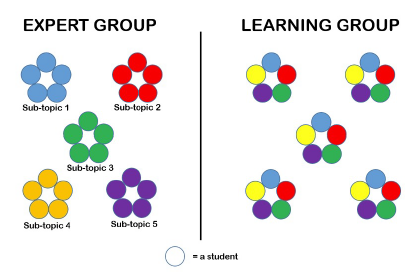
2. Students are then split into groups with one group assigned to each topic. This is called the
Expert Group. They work together on understanding the sub-topic at hand and create teaching material (usually a one page note) to prepare for the next phase. Suggested time: 20 minutes.
3. Next, the class is split again into the
Learning Groups. Each Learning Group has at least one member for every
Expert Group, representing all the sub-topics given earlier. Each student presents the sub-topic to the members of the group. Each
Learning Group member compiles the notes. Suggested time: 40 minutes.
4. Finally, the original
Expert Groups reconvene and compare notes. This final presentation provides all group members with the findings that have emerged from the
Learning Group discussion. Suggested time: 20 minutes.
Pro-tip: Use a big clock or a timer to control the discussion time – because they will almost definitely go over the 2-hour period.
So what do you do? Brief the learning outcomes and the learning process clearly. And then, sit back, keep time, and let the learning happen. Facilitate the discussion by giving feedback once in a while during the group discussions. Don’t forget to practice little reflection at the end of the class as a closure. Try on simpler, easily digestible topics to experiment. In my own experience, it took me at least two attempts to get it right and flowing.
“Congratulations, you have now transformed your 50-page walls-of-text Powerpoint slides into one meaningful learning activity.”After experimenting with this, I realized that my previous attempts at student-centered learning were lacking the elements of interdependence and individual responsibility. The students didn’t feel the need to learn with and from the rest. In group work, they don’t feel the responsibility to learn and contribute. The jigsaw technique I think tackles both problems quite nicely. The sense of responsibility comes when they realize that they need to present something to their peers. This is instilled when they are preparing materials in the first phase Expert Group. Then, the students depend on each other when they need to learn about the big topic (complete the ‘jigsaw’) in the Learning Group.

Ideally, I would like for all my students to learn how to work cooperatively with others, compete for fun and enjoyment, and work autonomously on their own. The lecturer’s role is to decide which goal structure to implement within each lesson. To do this, again, it is important for the students to have a sense of authority, a will to dictate their own learning – responsibly.

THE AUTHOR
Dr. Ahmad Salahuddin Mohd Harithuddinis a Senior Lecturer in the Department of Aerospace Engineering,Faculty of Engineering, Universiti Putra Malaysia. He spends too much time on the innovation of teaching and learning at the Faculty of Engineering and the University. This is one part of the series on Atomic Teaching-Little Change, Big Impact which aim to introduce simple and practical ideas to improve teaching in Engineering.
__________________________________________________________________________________________________________________________________________________________________
Published: November 14, 2022 12:14 pm
Article of The Month
“MUSIC AND THE BRAIN: HOW DOES MUSIC AFFECT YOUR BRAIN?”
Published: November 14, 2022 12:17 pm
Dr. Mohd Na’im Abdullah
naimabdullah@upm.edu.my

Something about hearing your favourite tunes playing on the radio can instantly transform a dreary commute into an exciting adventure. And it is almost amazing how your playlist can make an unpleasant day into a wonderful evening. Do you ever wonder why?
Music is structural, mathematical and architectural. It is based on relationships between one note and the next or some might call it “chord progressions”. One of the most instantly recognisable pieces of classical music ever created is without a doubt Pachelbel's Canon in D. The chord progression is perfectly balanced, a great illustration of how powerful and weak progressions can coexist, and it would fit nicely with any kind of music.
"Pachelbel's following me. It sounds paranoid but he's following you too, you hear him every day."
— Rob Paravonian
So how does music really affect our brain? In a research study published in 2011, it was found that when you are enjoying music you, your dopamine levels, which are your “happy brain chemicals, increase and cause your brain to have a peak emotional response to the music. In other words, you begin to feel joyful. Your brain's reward response is brought on by dopamine, thus the more you listen to pleasant music, the more you trick your brain into believing you are being rewarded. The brain can even anticipate the most enjoyable peaks in familiar music and ready itself with an early dopamine rush since this response is so swift. Dopamine plays a key role in shaping and sustaining behaviour. Music-induced emotional states might trigger the release of dopamine, which may help to explain why musical experiences are so valued [1].
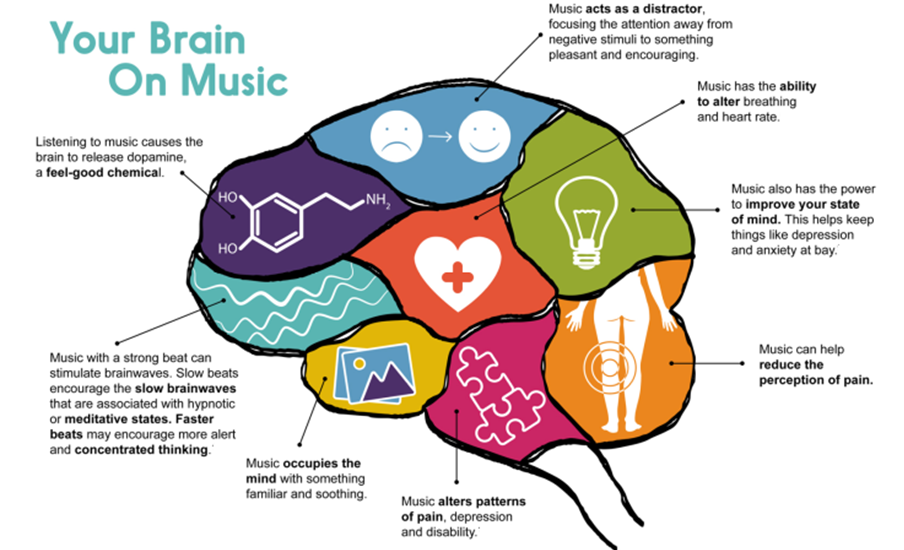
Fig 1 Your brain on music [2]
Beyond simply making you just to feel good, there is also evidence that music can even be good for your health. Music enhances creative energy and brain function through alpha waves, which promote sensations of enhanced creativity and theta waves, which are linked to learning, dreaming, and relaxation. But the common question in our mind, are we able to force ourselves to be in a good mood and release the dopamine hormones just by listening to happy music? Researchers Yuna Ferguson and Kennon Sheldon discovered that listening to a music that makes you happy, with the intention of being happy, can take part in controlling your mood [3].
Numerous advantages of music for the brain are not confined to any single genre. Whether you are listening to the teenage angst of The Ramones “Blitzkrieg Bop” on vinyl, the classical orchestral work of Ludwig Van Beethoven “5th Symphony in C Minor” on YouTube, or The Who “My Generation” and their powerful British Invasion rock music on Spotify, different styles can produce the same results as long as they are aligned with your musical preferences. In this way, it is the brain's relationship with familiar and favoured music that is key. In other cases, the style of music can play a role. While listening to music that you know and like tends to cause the strongest brain response and dopamine release, trying unfamiliar melodies may stimulate your brain and provide a new source of pleasure as you get used to hearing them. Expert suggest that while learning, different genres had a different effect on the listener.

Fig 2 Joey Ramone holding The Ramones debut album vinyl
Meanwhile, in learning, experts recommend different genres for different purposes. Positive lyrics and upbeat music can give you a surge of energy and prime your brain for learning. However, instrumental music and calming genres can keep you quiet and concentrated when it is time to focus, such as when you have to read, write, or study your course materials. However, in the end, each person may discover a method of learning and music that is specifically suited to them.
Child and Adolescent Mental Health Services produced an infographic which shows six benefits of music for your mental health. Music can be used to relax, to boost and lift our mood, or to improve concentration. Music can also be used to aid in insomnia, helping to encourage and induce a deeper sleep. It’s only been in recent years that research has suggested music can help combat depression and anxiety, along with a host of other mental health issues. Music therapy is one technique administered by health care professionals to help support people as they strive to improve and gain control over their mental health, functioning, and well-being.
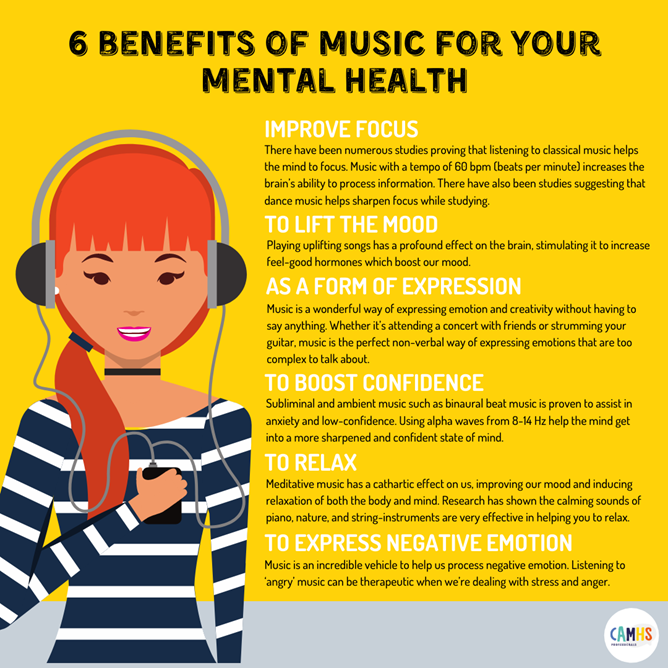
Fig 3 Benefits of Music for Your Mental Health [4]
It's also undeniable that a lot of individuals used music to cope through the pandemic. Most social activities were severely curtailed by the pandemic for nearly a year. We were forbidden from going out, working out in the gym, and hanging out with friends. We all felt so lonely, anxious, and bored at the same time. Instead of thinking of music as pure entertainment, consider some of the major mental benefits of incorporating music into your everyday life. As a result, you might discover that you are happier, more motivated, and more at ease. In addition to inspiring and amusing, music has strong psychological impacts that can enhance your health and wellbeing. If you are unhappy, try listening to or making music to improve your mood or relieve feelings of depression. Dance, sing or move to music. These activities not only provide physical exercise, but they can also relieve stress and build social connections and they're fun ways to stimulate your brain.
- Salimpoor, V. N., Benovoy, M., Larcher, K., Dagher, A., & Zatorre, R. J. (2011). Anatomically distinct dopamine release during anticipation and experience of peak emotion to music. Nature neuroscience, 14(2), 257-262.
- Can Music Really Affect Our Mood? (n.d.). VIBE 105. Retrieved October 31, 2022, from https://www.vibe105to.com/t
- Ferguson, Y. L., & Sheldon, K. M. (2013). Trying to be happier really can work: Two experimental studies. The Journal of Positive Psychology, 8(1), 23-33.
- Benefits Of Music For Your Mental Health. (2020, October 30). https://camhsprofessionals.co.uk/2020/10/30/benefits-of-music-for-your-mental-health

THE AUTHOR
Dr Mohd Na'im Abdullah
is a Lecturer in the Department of Aerospace Engineering,
Faculty of Engineering, Universiti Putra Malaysia.
_________________________________________________________________________________________________________________________________________________________________
Published: November 30, 2022 5:30 pm
Article of The Month
“HOW STRESS AFFECTS YOUR BODY?”
Published: November 30, 2022 5:30 pm
Dr. Ain Umaira Md Shah
ainumaira@upm.edu.my
Cramming for a test? Trying to get more done than you have time to do? Stress is a feeling we all experience when we are challenged or overwhelmed. But more than just an emotion, stress is a hardwired physical response that travels throughout your entire body. In the short term, stress can be advantageous, but when activated too often or too long, your primitive fight or flight stress response not only changes your brain but also damages many of the other organs and cells throughout your body. Your adrenal gland releases the stress hormones cortisol, epinephrine, also known as adrenaline, and norepinephrine. As these hormones travel through your blood stream, they easily reach your blood vessels and heart. Adrenaline causes your heart to beat faster and raises your blood pressure, over time causing hypertension.
Cortisol can also cause the endothelium, or inner lining of blood vessels, to not function normally. Scientists now know that this is an early step in triggering the process of atherosclerosis or cholesterol plaque buildup in your arteries. Together, these changes increase your chances of a heart attack or stroke. When your brain senses stress, it activates your autonomic nervous system. Through this network of nerve connections, your big brain communicates stress to your enteric, or intestinal nervous system. Besides causing butterflies in your stomach, this brain-gut connection can disturb the natural rhythmic contractions that move food through your gut, leading to irritable bowel syndrome, and can increase your gut sensitivity to acid, making you more likely to feel heartburn.
Via the gut's nervous system, stress can also change the composition and function of your gut bacteria, which may affect your digestive and overall health. Speaking of digestion, does chronic stress affect your waistline? Well, yes. Cortisol can increase your appetite. It tells your body to replenish your energy stores with energy dense foods and carbs, causing you to crave comfort foods. High levels of cortisol can also cause you to put on those extra calories as visceral or deep belly fat. This type of fat doesn't just make it harder to button your pants. It is an organ that actively releases hormones and immune system chemicals called cytokines that can increase your risk of developing chronic diseases, such as heart disease and insulin resistance.
Meanwhile, stress hormones affect immune cells in a variety of ways. Initially, they help prepare to fight invaders and heal after injury, but chronic stress can dampen function of some immune cells, make you more susceptible to infections, and slow the rate you heal. Want to live a long life? You may have to curb your chronic stress. That's because it has even been associated with shortened telomeres, the shoelace tip ends of chromosomes that measure a cell's age. Telomeres cap chromosomes to allow DNA to get copied every time a cell divides without damaging the cell's genetic code, and they shorten with each cell division. When telomeres become too short, a cell can no longer divide and it dies.
As if all that weren't enough, chronic stress has even more ways it can sabotage your health, including acne, hair loss, sexual dysfunction, headaches, muscle tension, difficulty concentrating, fatigue, and irritability. So, what does all this mean for you? Your life will always be filled with stressful situations. But what matters to your brain and entire body is how you respond to that stress. If you can view those situations as challenges you can control and master, rather than as threats that are insurmountable, you will perform better in the short run and stay healthy in the long run.
References
[1] Transcripted from “How stress affects your body – Sharon Horesh Bergquist” by Sharon Horesh Bergquist, TED-Ed channel, 30 November 2022.
YouTube link: https://www.youtube.com/watch?v=v-t1Z5-oPtU

THE AUTHOR
Dr. Ain Umaira Md Shah
is a Lecturer in the Department of Aerospace Engineering,
Faculty of Engineering, Universiti Putra Malaysia.
_________________________________________________________________________________________________________________________________________________________________
Published: January 14, 2023 5:30 pm, Updated: February 14, 2023
Article of The Month
“ KALMAN FILTER: A SIMPLE CONCEPT THAT SHIFT PARADIGM!”
Published : January 14, 2023
Dr. Md. Amzari Md Zhahir
amzari@upm.edu.my
Let assume that our estimate is to be the sample mean and that we wish to refine our estimate with each new measurement as it becomes available. That is, think of processing the real-time data on-line implementation. Imagine that you have a simple generated deterministic data set of measurement sequence (as an example) as follows:
5, 7, 9, … (so on and so forth)
or in generic terms:
4. And so forth.
Clearly, this would yield the correct sequence of sample means as the experiment progresses. It should also be clear that the amount of memory needed to store the measurements keeps increasing with time, and also the number of arithmetic operations needed to form the estimate increases correspondingly. This would lead to obvious problems when the total amount of data is large. Thus, consider a simple variation in the computational procedure in which each new estimate is formed as a blend of the old estimate and the current measurement. To be specific, consider the following algorithm (Kalman filter):
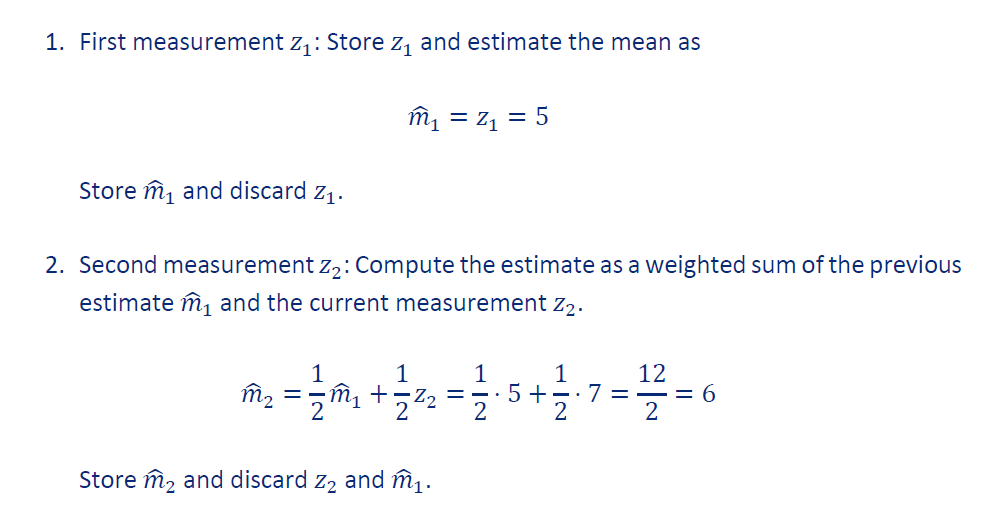

Clearly, the above procedure yields the same identical sequence of estimates as before, but without the need to store all the previous measurements. We simply use the result of the previous step to help obtain the estimate at the current step of the process. In this way, the previous computational effort is used to good advantage and not wasted. The second algorithm can proceed on ad infinitum without a growing memory problem. Eventually, of course, as n becomes extremely large, a round-off problem might be encountered. However, this is to be expected with either of the two algorithms.
The second algorithm is a simple example of a recursive mode of operation The key element in any recursive procedure is the use of the results of the. Previous step to aid in obtaining the desired result for the current step. This is one of the main features of Kalman filtering, and one that clearly distinguishes it from the weight-factor (Wiener) approach.
Hence, this is the essence of Kalman filter, definitely a simple concept that shift paradigm!
The term Kalman filter was coined as an honour to Rudolf E. Kalman, who published his famous research entitled “A New Approach to Linear Filtering and Prediction Problems” in 1960.
Now, to implement Kalman filter properly, instead of deterministic data set of measurement sequence, this recursive philosophy must apply estimation of a random process using stochastic data set of measurement sequence and both the process and the measurement noise must be modeled in vector form, assuming Gaussian error statistics, normally distributed white noise. For that my friend, is another story for another time.
References
1] Adapted from Brown, R.G. and Hwang, P.Y.C. (1997). Introduction to Random Signals and Applied Kalman Filtering with MATLAB Exercises and Solutions (3rd ed.), Wiley. Pages 190-192 with a simple generated deterministic data set of measurement sequence as an example for more clarity.
[2] Kalman, R. (1960). A New Approach to Linear Filtering and Prediction Problems. ASME Journal of Basic Engineering, 82, 35-45. http://dx.doi.org/10.1115/1.3662552

THE AUTHOR
Dr. Md Amzari Md Zhahir
is a Lecturer in the Department of Aerospace Engineering,
Faculty of Engineering, Universiti Putra Malaysia.
Writer's Block-Student Edition
SUMMER EXCHANGE AND INTERNSHIP PROGRAM IN TURKIYE
Published: Februari 14, 2023 4:00 pm
Nur Izzari Barry Bintu Abdul Rashid
202790@student.upm.edu.my
I have always dreamt of exploring life outside of Malaysia and in May 2022 I found out a way to make those dreams come true. The best choice I ever made was applying to the Sky Global Summer Exchange & Internship Program 2022 in Turkiye. I applied in May of 2022 I submitted my very first professional resume to them and one month later I was ecstatic to receive an email that I was accepted.
I'm excited to write about my participation in this fully funded program, organized by Turkish Aerospace (TUSAS) and Yunus Emre Enstitusu (YEE), since it gave me and the other 9 engineering students an excellent opportunity to expand our knowledge and sharpen our talents. The 10 engineering students chosen came from Malaysia, Azerbaijan, Kazakhstan, Uzbekistan, Pakistan, and Poland. However, we also had the chance to meet the other interns from Bangladesh and Malaysian UniKL students. We were divided into several departments based on our majors. Some of the majors are computer engineering, mechanical engineering, and electrical engineering.
As an Aerospace Engineering student, I was assigned to the Aircraft System Engineering Department under the supervision of my supervisor, Mr. Ayhan. I was exposed to system engineering processes, which was definitely new to me. System engineering works closely with the project in tailoring the generic life cycle, including the decision gates, to meet the needs in the specific project. Also, I had the chance to check on the critical design review report of an aircraft which I learned more in details on every part of the aircraft like flaperon which combines both of the flap and aileron of the aircraft. Other than that, I am able to read on the performance evaluation report on one of the aircraft prototypes that is still in the assembly process. This is new information for me as we only learned about commercial aircraft at university. I learned a lot more, especially about the combat jet's mission profile.

Mr Arda, the chief of engineering, was extremely kind and gave me a thorough tour of all the facilities, where I was able to observe the assembly of the aircraft prototype. The whole facility area was huge which covers an area of 4 million square meters and also for the production for other aircraft like the Hurkus Aircraft, UAV Anka, helicopter Atak and many more. Although the subjects I learned were not directly applied, I was able to make sense of all the knowledge I have learnt to help me strive as in intern there. The three weeks I spent at TUSAS were unquestionably beneficial to me.

Apart from that, we were fortunate in that the Yunus Emre Institute organized a cultural exchange during our final week in Turkiye, and I was able to see the beauty of Turkiye while visiting popular places in Istanbul, Ankara, and Cappadocia. We spent about 3 days in Istanbul where we visited Ayasofya mosque, Galata tower, Galata Bridge and also went for a private boat tour which we can observe both Euro and Asia side of Turkey. While we are in Ankara, we visited the Anitkabir where there’s Ataturk tomb and there was a ceremonial for the people to show respect to Ataturk as he was an army officer who founded an independent Republic of Turkey our of the ruins of the Ottoman Empire. Lastly, we visited Cappadocia where we were so lucky as they have reserved a slot for us to watch the sunrise from the balloon tour which was a magnificent experience.

Overall, Turkiye was a great experience for me from both educational and cultural side. Hence, I would encourage to my batch mates and juniors to apply the same program next year as I was told that both TUSAS and YEE would try to make the program as yearly program.Overall, Turkiye was a great experience for me from both educational and cultural side. Hence, I would encourage to my batch mates and juniors to apply the same program next year as I was told that both TUSAS and YEE would try to make the program as yearly program.
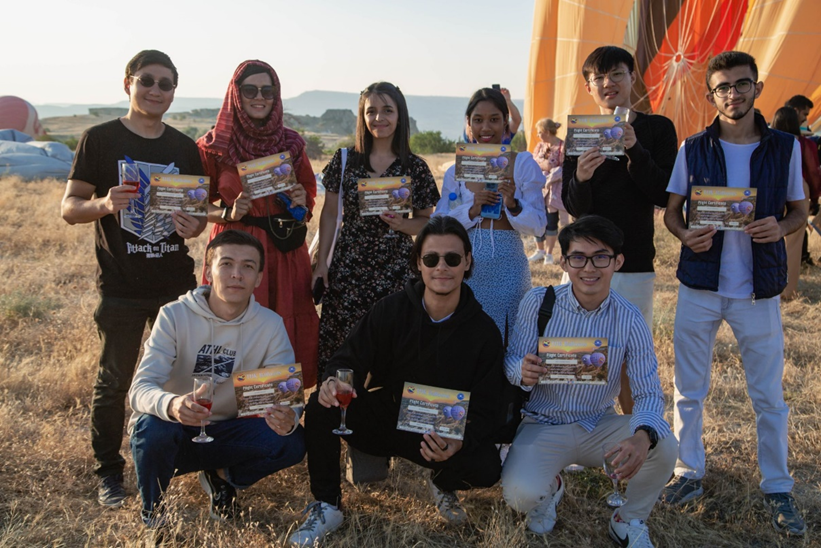

THE AUTHOR
Nur Izzari Barry Bintu Abdul Rashid
is a 4th year student in the Department of Aerospace Engineering,
Faculty of Engineering, Universiti Putra Malaysia.
___________________________________________________________________________________________________________________________________________________________________
Published: Mac 14, 2023 10:00 am
Article of The Month
“INTERNATIONAL WOMEN'S DAY 2023: PROMOTING WOMEN'S ROLE IN AEROSPACE INDUSTRY”
Published: March 14, 2023 10:00 pagi
Dr. Ermira Juanita Abdullah
ermira@upm.edu.my
The International Women's Day is celebrated each year on the 8th of March to celebrate women’s achievement, raise awareness about discrimination and take action to drive gender parity.1 It has been well established that diversity in any organization provides a positive impact and many industries seek to put in place concrete policies to promote diversity.
However, in some industries such as aviation, it is still highly male-dominated. Of the 130,000 airline pilots in the world in the early 2010s, 3 per cent, were women, and of these only 450 were captains.2 According to another source the number of women pilots in 2018 was 7,409, representing 5.2 per cent of the total number of pilots.3 The occupation of aircraft mechanic is even more male-dominated. In 2018 only 7,133 of 290,002 active certified mechanics in the United States were women.4
In Malaysia, the number of female aerospace engineering graduates has been increasing over the years, but it does not translate to increase in the number of female technical professionals in the industry. Compared to other industry, there is still a lot of catching up to do. The issue is on the recruitment, retainment and promotion. Women in aerospace struggle during studies, in the stage of breaking into the job market, in maintaining their career and climbing the ladder. Creating awareness, providing support and solid action by the stakeholders may improve the situation.
Aerospace Society Malaysia (AEROS), has recognized that there are many challenges in the aerospace sector, and this includes the lack of diversity. AEROS has been actively trying to address this issue through the various programs and activities that has been organized to promote women empowerment. AEROS ensures the presence of women members in various roles either in the organizing committee, as speakers, facilitators or participants. This serves to be a platform for women to create role models and promote visibility of women in the aerospace sector.
Moving forward, public dialogues and forums may promote a positive impact to ensure that the aerospace industry is aware of the need promote diversity. Concrete steps and policies need to be implemented to forge inclusive work cultures where women's careers thrive and their achievements are celebrated.
References
[1] https://www.internationalwomensday.com/
[2] McCarthy, F., Budd, L. and S. Ison, 2015. “Gender on the flightdeck: Experiences of
women commercial.
[3] ICAO, Global Aviation Gender Summit, 9 Aug. 2018, Session 4: Cultural stereotypes.
[4] FAA, 2018, US Active Civil Airmen Statistics.

THE AUTHOR
Dr. Ermira Juanita Abdullah
is a Senior Lecturer in the Department of Aerospace Engineering,
Faculty of Engineering, Universiti Putra Malaysia.
__________________________________________________________________________________________________________________________________________________________________
Diterbitkan: Mac 20, 2023 3:45 petang
KAA Online Bulletin 1st Quarter 2023 (Click cover for next reading)
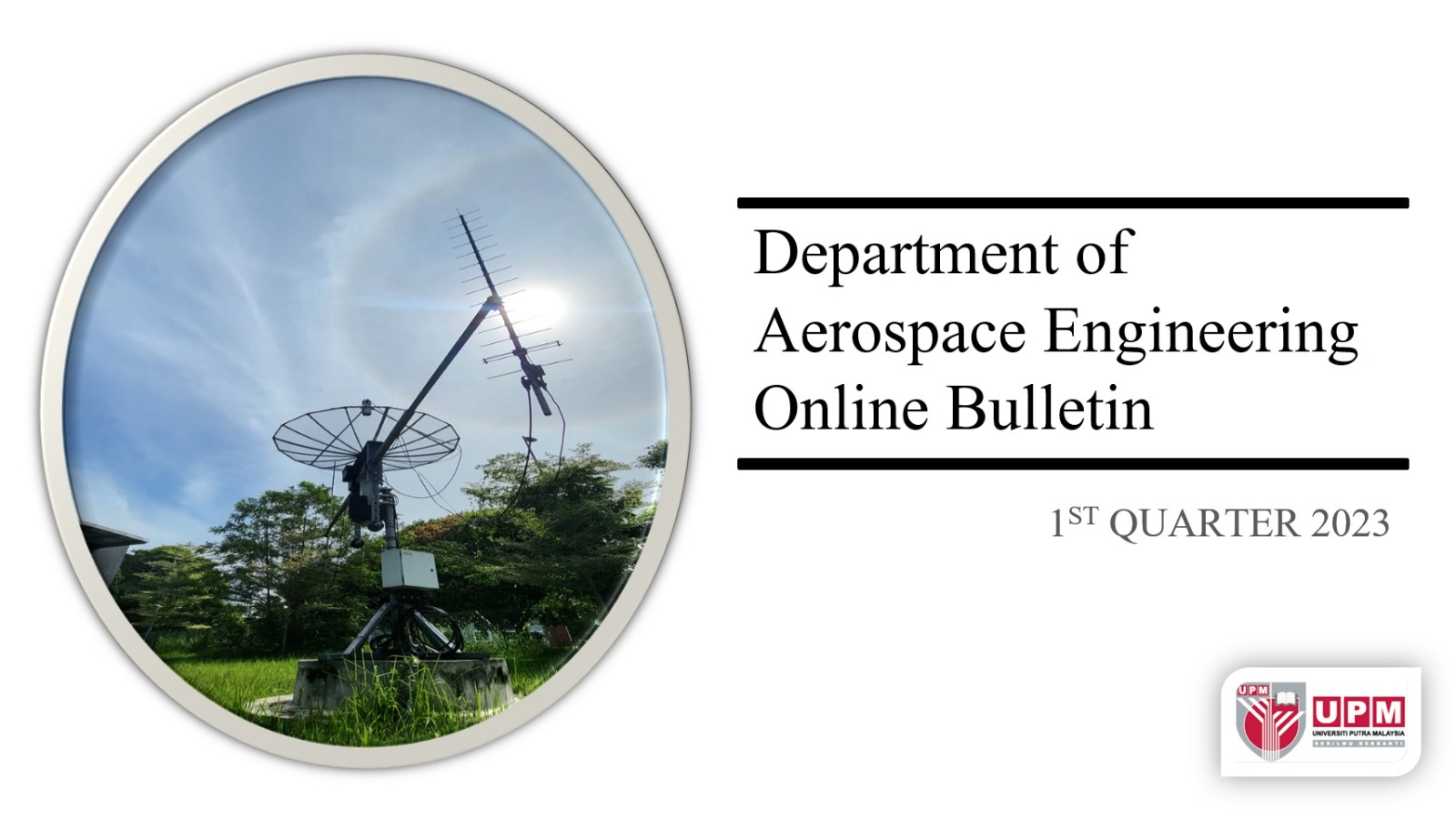
Diterbitkan: April 11, 2023 1:00 PM
Article of The Month - MARCH 2023
“HOW ENGINEERS MAKE THE BEST ENTREPRENEURS”
Dr. Adi Azriff Basri
adiazriff@upm.edu.my

lon Musk, Bill Gates, Henry Ford.
Have you heard of them?
I bet you have! Some of the most successful and most famous Entrepreneurs out there, have come from Engineering backgrounds.
In fact in a 2012 ‘Identified’ survey carried out into entrepreneurship, it was found that there were 3 times as many CEO’s with advanced degrees in Engineering than there were CEO’s that had an MBA.
Entrepreneurship has been one of the most talked about and sought-after career paths and has been glamorized in the recent years by young billionaires like Zuckerberg and Musk.
Engineering and entrepreneurship at first seems like very different paths without natural crossovers, but looking closely, you find that engineering and entrepreneurship share many of the same skills. In fact, many great entrepreneurs and business leaders do in fact have education and training in engineering. Bill Gates, Michael Bloomberg and Carlos Slim are just a few of the famous entrepreneurs who all started their careers in Engineering.
But what are the traits that make Engineers such a good Entrepreneurs?

- Great Problem Solving Skills
Engineers, by nature, are fantastic problem solvers. Their whole career revolves around building things in order to solve problems. When it comes to creating and developing a viable product/service in the entrepreneurial world, whatever you are developing has to solve a problem in order to satisfy the market. Engineers have the training and the ability to understand a wide range of possible solutions to a problem and to proceed with the most relevant for the overall goal at hand.
- Mathematically Minded
Engineers are extremely mathematically minded having an extensive knowledge of physics and have a way with numbers. Armed with a skill such as this one, entering the entrepreneurial world becomes instantly less daunting and allows for a greater insight into the probable viability of an innovation. Engineers possess an ability to focus on data and understand how numbers work in real life situations. This means calculating profit/loss accounts and understanding balance sheets comes second nature to them.
- Understand the Importance of a Team
While working on projects, engineers nearly always work as part of a team. Engineers understand that different perspectives and skill sets are crucial to the progression and success of a project. Another aspect of teamwork that engineers understand is that other members are need to delegate work to. No man is an Island and with financial and time constraints, working as part of a team gets the work done. These insights and understanding are crucial when creating an Enterprise. Two heads are better than one.
- Excellent at Planning
On any project that an Engineer works on, they know that planning is the most crucial element. Plans, designs and research needs to be drawn up before any physical work can begin. Entrepreneurs on the other hand have a tendency to rush into the development of a product before important foundation research has been completed: market research, financial projections, the development of a business plan. Without planning, entrepreneurial ventures can and do fall flat. Engineers however possess the knowledge that planning is key.
- Technical Understanding
There is no doubt that the growing business world is become ever more technical in nature. Engineers have the upper hand when it comes to innovation as they truly understand how the technicality works. Engineers understand the ins and outs of product development and therefore make great business leaders.
- Trustworthy
Where some business people are known for being shady or deceitful when it comes to gaining the upper hand. Engineers, by-and-large, are known for their practicality, logic and truth telling (often in a very blunt manner). Due to the practicality of the profession, Engineers know that one cannot pretend or deceive consumers or customers if there is an actual issue. This would only cause the entire project to come tumbling down. This forward facing truth means that Engineers are perceived as trustworthy in the business world, adding to their business success.
- Optimistic
The job of an Engineer depends on their ability to be optimistic with their work. I am not talking about blind optimism, entering into a project and hoping for the best. I am talking about persisting with whatever course of action is deemed appropriate, overcoming obstacles and working until a problem is solved. Faced with the likes of financial crises, cultural barriers or societal issues, Engineers are trained to find away to create a positive outcome and they know in their minds that they are capable of this. Entering into a business venture with an optimistic outlook and the skills and traits that I have mentioned above is a sure set up for a successful entrepreneur.
- Constant Self Evaluation
Engineers are constantly examining their projects or prototypes in order to find better solutions and make changes quickly and efficiently. There needs to be constant self evaluation in order to persevere when the challenges that lay ahead seem great. Engineers have been taught and trained to constantly evaluate their progress and so make great entrepreneurs.
From the socially awkward, highly technical designers and coders to team leaders, innovators and investigators, what has been deemed ‘The New Engineer’ is equipped with talents skills and a drive that will give entrepreneurs from all other areas a run for their money.
Engineers make great entrepreneurs because they bring a skillset to the startups that’s been developed over years of managing projects and solving big problems.
Enormous amounts of planning go into projects that engineers have to complete. And what can be a bigger project that starting out on a journey of entrepreneurship? So go on, engineers: you are already great at building — time to think about building a company.
References
Updated:: 24/10/2023 [firdaus.abas]
MEDIA SHARING












